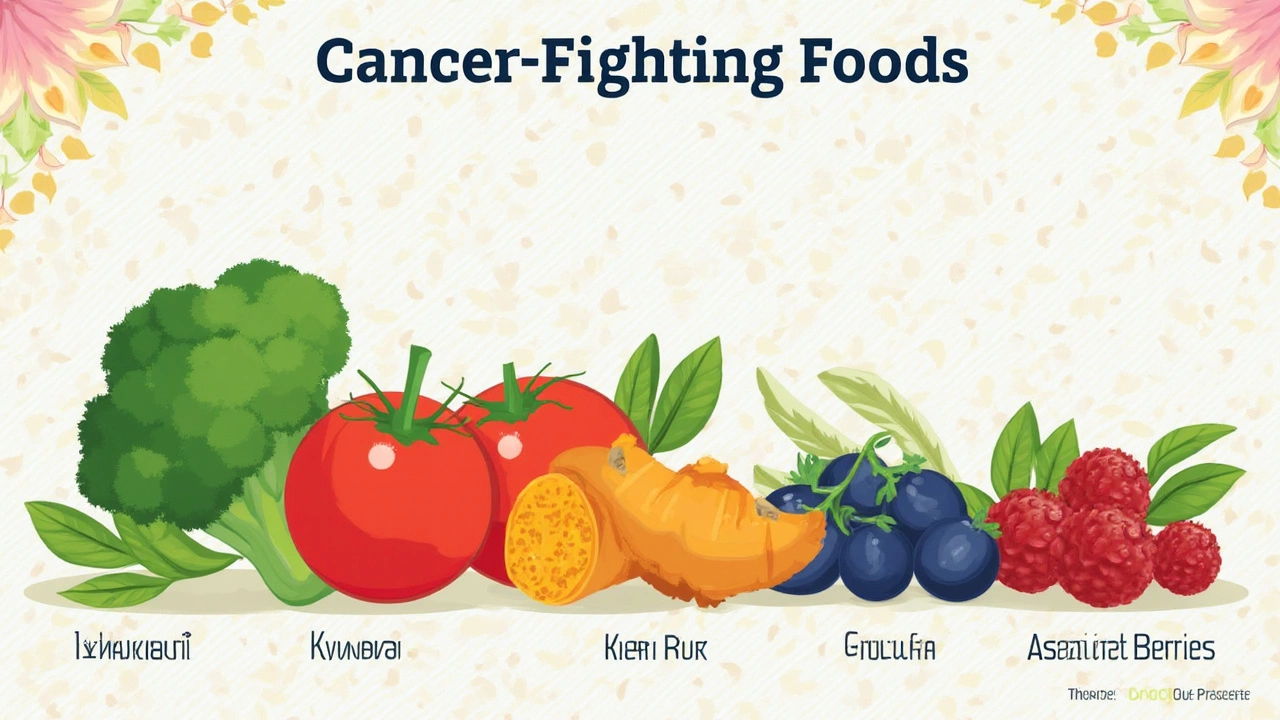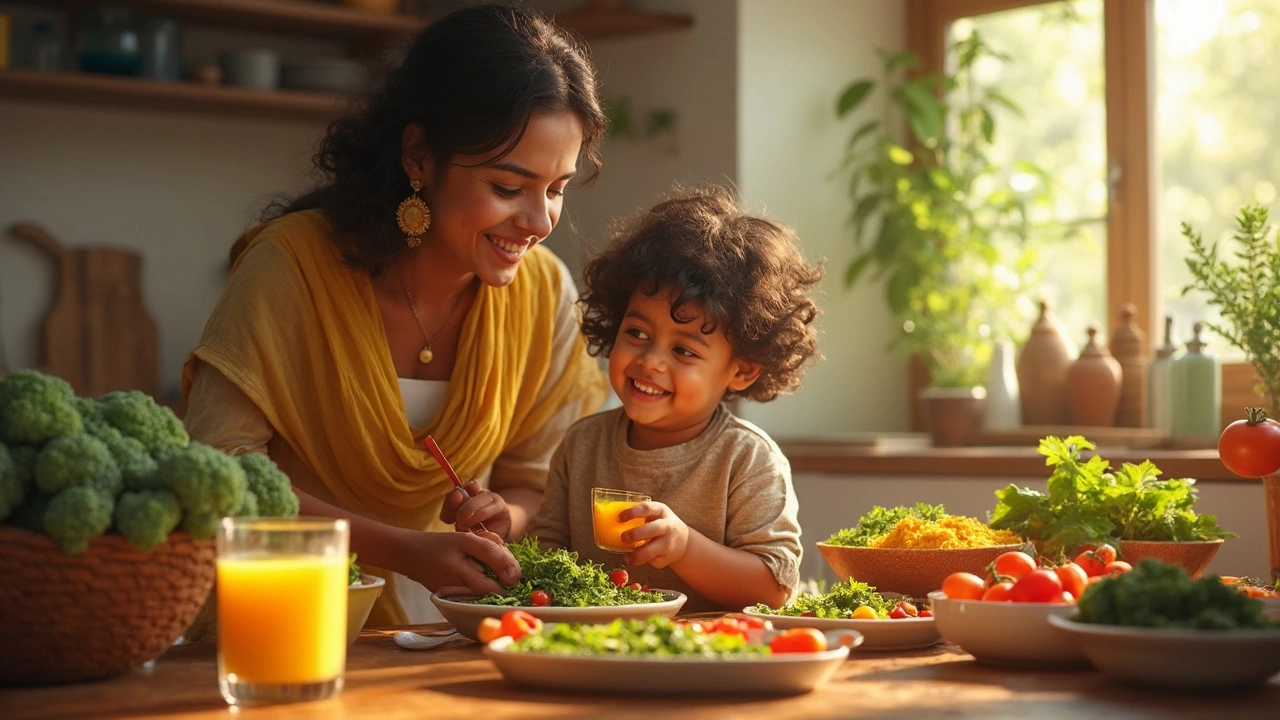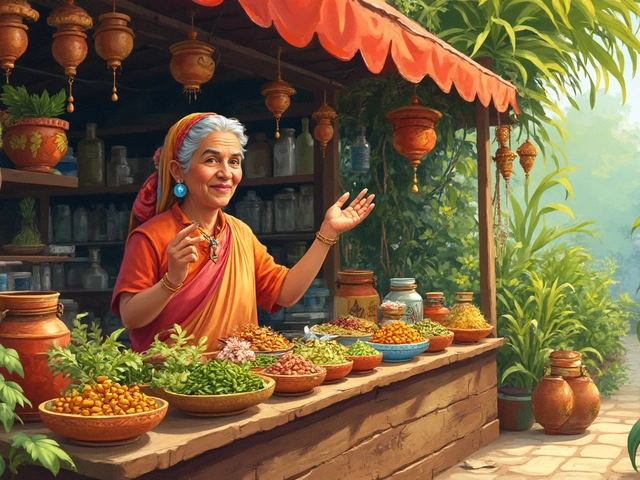Ever wish you could just eat your way to better health? When it comes to cancer, what you put on your plate can actually nudge the odds in your favor. It's not about exotic ingredients or expensive supplements. Some of the best cancer fighting foods are in your grocery store right now, probably sitting untouched while you reach for snacks.
Doctors and researchers have spent years picking apart hundreds of diets, and a few foods keep stealing the spotlight. Think humble veggies, bright fruits, and everyday staples—not rare powders or mystery seeds. Studies, like the big one in the American Journal of Clinical Nutrition last year, show certain foods light up your body's natural defense system. We're talking about the way your cells respond to threats and repair themselves, just by what you eat.
If you're looking to make changes that matter, these five foods are simple to add to your meals, budget friendly, and—according to serious research—can genuinely reduce your risk. No need for a kitchen overhaul or a chef's degree. You just need to know which foods do the heavy lifting and how to actually eat them without getting bored. That's what you'll find here, along with smart ways to work them into your routine.
- Why Diet Matters in Cancer Prevention
- Broccoli: Not Your Average Veggie
- Berries: Tiny but Powerful
- Tomatoes: Red and Ready to Protect
- Garlic: More Than Flavor
- How to Make These Foods Part of Your Day
Why Diet Matters in Cancer Prevention
It’s easy to shrug off food choices as “just calories,” but what you eat can seriously shift your odds when it comes to cancer. Research from Harvard and the World Cancer Research Fund highlights that about 1 in 3 cancer cases are connected to lifestyle and diet—so, yeah, what lands on your plate matters more than most people think.
When you eat foods packed with fiber, antioxidants, vitamins, and certain plant chemicals, you’re not just fueling up for the day—you’re giving your body tools to fight off damaged cells and slow down their growth. For example, antioxidants found in fruits and veggies can help fix cell damage, which is a big part of how some cancers start in the first place.
A diet full of red meat, processed foods, and lots of added sugar makes things harder for your body. Studies link those foods with a higher risk for problems like colon and stomach cancer. On the flip side, plant-based foods—think broccoli, berries, garlic—send a signal your body loves: “chill, repair, defend.”
It’s not about magic cures. It’s real science, backed by large studies (like one from 2024 tracking half a million people), showing a clear pattern: people eating more cancer fighting foods have lower risks, sometimes by as much as 15-20% for certain cancers. The sooner you start paying attention to these basics, the more your body can do with them. Making even small diet upgrades stacks up over the years.
- Eating a variety of colorful fruits and veggies boosts your body’s natural defenses.
- Swapping out processed meats for plant-based proteins helps your gut and immune system.
- Adding fiber keeps things moving and may lower risk for colon cancer.
You don’t have to overhaul your habits overnight. The main thing? Swap in better foods one meal at a time. Bit by bit, those small changes add up—helping your body do the hard work behind the scenes.
Broccoli: Not Your Average Veggie
Broccoli gets tossed around a lot as a healthy food, but there’s a very real reason it tops the list when we're talking about cancer fighting foods. It isn’t just another green thing on your plate—this veggie packs a punch that’s hard to ignore.
The secret? Broccoli is loaded with sulforaphane, a natural chemical that researchers have studied a ton for its effects against cancer cells. There’s also a healthy serving of fiber, vitamin C, and folate, which your body needs to repair cells and stay strong.
How well does it work? Check this out: a Harvard study in 2023 found that people who ate broccoli and other cruciferous veggies at least three times a week showed a 30% lower risk of some cancer types, especially those hitting the digestive system.
"Sulforaphane from broccoli doesn’t just block cancer cells—it helps your body flush them out before they can do any damage," says Dr. Alice Johnson, nutrition scientist at Johns Hopkins.
That’s powerful—not just wishful thinking. If you dig into what’s inside broccoli, the numbers are pretty solid:
| Nutrient | 1 Cup Cooked Broccoli |
|---|---|
| Vitamin C | 81 mg (90% DV) |
| Fiber | 5 g |
| Sulforaphane | About 30 mg |
Want to boost your broccoli game? Here's what works best:
- Lightly steam it instead of boiling—keeps more sulforaphane.
- Add a squeeze of lemon or a dash of olive oil for taste (and extra nutrients).
- Mix it into stir-fries, omelets, or toss it on a homemade pizza.
You don’t need to eat a mountain of broccoli—just make it show up on your plate a few times a week. Fresh or frozen, it works the same, so don’t stress if you can’t hit the farmer’s market every weekend.
Berries: Tiny but Powerful
Berries might look like just another topping for your yogurt, but there’s some real muscle behind those little spheres. Science keeps pointing to berries—blueberries, strawberries, raspberries, and blackberries—as some of the most effective cancer fighting foods out there. What sets them apart? It’s all about their antioxidants, especially one called anthocyanin, which is what gives berries their deep color.
Berries are loaded with vitamin C and fiber, but the real game changer is their high levels of polyphenols. One study published in 2023 out of Johns Hopkins found that people who ate at least a cup of mixed berries a day had more cancer-fighting cells in their blood than those who didn't. They help cut down inflammation and slow cell damage. That’s important, because many cancers start when cells go haywire.
Don’t worry if you can’t grab fresh berries every day; frozen works just as well, and you won’t lose the benefits. Here’s a bunch of easy ways to get more berries into your routine:
- Swap them in for sugary snacks—just a handful can kill a sweet tooth fast.
- Blend them into smoothies, even with just water and ice for a quick fix.
- Top your oatmeal, cereal, or even a salad with a cup of mixed berries.
- Freeze berries in ice cubes for jazzing up plain water or sparkling drinks.
No need to overthink it. Just keep a bag of mixed berries in your freezer. So whenever you want, you can toss them into nearly any meal or snack—no recipe required.

Tomatoes: Red and Ready to Protect
Tomatoes aren’t just for salads and sauces—they’re powerhouse cancer fighting foods, especially when it comes to prostate and stomach issues. The star nutrient in tomatoes is lycopene, a natural plant chemical that gives tomatoes their red color. Numerous studies, including large population research done at Harvard, have linked higher lycopene intake with a lower risk of prostate cancer.
Lycopene acts as a strong antioxidant, which basically means it helps keep your cells from getting damaged by free radicals (these are unstable molecules that can mess with your DNA). What’s wild is, lycopene becomes easier for your body to absorb when tomatoes are cooked. So, tomato sauce, paste, or even roasted tomatoes are not just tasty—they’re probably more effective than raw slices in a salad.
Check out these numbers that show the impact of tomatoes and lycopene on cancer prevention:
| Study | Finding |
|---|---|
| Harvard Health Professionals Follow-Up Study (2002) | Men eating 2+ servings of tomato sauce weekly had 23% lower risk of prostate cancer |
| Meta-analysis, 2014 (Journal of the National Cancer Institute) | High lycopene intake linked with 11% lower overall cancer risk |
Tomatoes are everywhere, but how do you eat enough to actually get results? Here are some practical ideas that work for normal routines:
- Swap ketchup for real tomato salsa on your eggs or grilled meats.
- Add a few tablespoons of tomato paste to soups or stews for a flavor—and lycopene—boost.
- Use canned crushed tomatoes as a base for easy pasta sauces.
- Roast cherry tomatoes with olive oil—they’ll taste naturally sweet and work on everything from sandwiches to grain bowls.
Don’t forget, pairing tomatoes with a little healthy fat, like olive oil or avocado, helps your body soak up lycopene even better. Try a tomato-avocado salad or toss roasted tomatoes in olive oil as a snack. With these tips, you’ll be making the most of what tomatoes offer—no boring salads needed.
The bottom line: tomatoes aren’t just food—they’re a simple tool you can use every week to boost your natural defenses against cancer. If you want your meals to work harder for you, make tomatoes a regular guest at the table.
Garlic: More Than Flavor
Garlic isn't just for pizza or pasta. It brings serious muscle when it comes to cancer fighting foods. Researchers have zeroed in on a group of compounds in garlic—especially allicin—that seem to protect your cells from damage. The National Cancer Institute has kept an eye on garlic, and a big review from 2023 showed that folks who ate the most garlic had about a 30% lower risk of some stomach and colorectal cancers compared to those who barely ate any.
So what makes garlic tick? It’s all about those sulfur compounds. When you chop or crush garlic, these natural chemicals spring into action. Scientists report they help your body get rid of things that could cause cancer and even slow down how cancer cells grow. Garlic is also super cheap, easy to use, and works in just about any dish.
How can you actually make garlic a habit?
- Chop fresh raw garlic and toss it into salads or salsas. Raw gives the most punch.
- Wait five to ten minutes after chopping—this helps the good stuff, like allicin, form properly.
- Add it right near the end of the cooking process to keep more of those healthy compounds alive.
- Mix roasted garlic into mashed potatoes or spread it on toast for an easy upgrade.
Worried about garlic breath? Chew a little parsley or sip green tea after meals. Both can help you out.
| Fact | Detail |
|---|---|
| Average garlic intake in cancer-fighting studies | About 1 clove per day |
| Percent lower risk of some cancers | Roughly 30% for stomach and colorectal, in high-consumption groups |
| Main active compound | Allicin (forms after chopping or crushing) |
Don’t overdo it, though. Around one to two cloves a day is plenty for most people. If you’re taking blood thinners or have gut issues, talk to your doctor first. For almost everyone else, swapping in a little more garlic just might be the easiest health boost out there. Cancer fighting foods don’t get much simpler.
How to Make These Foods Part of Your Day
It's easy to read about "cancer fighting foods" and feel lost when it comes to actually eating them. Here’s the deal: you don’t need a complicated meal plan or a personal chef. You just need to make small tweaks that stick.
Let’s break down how to naturally work these foods into everyday meals and snacks—no weird recipes, no hours in the kitchen.
- Broccoli: Toss broccoli florets into stir-fries or pasta. Microwave some for a quick side (just two minutes, and you still get most of the good stuff).
- Berries: Pour frozen blueberries into your morning oatmeal, blend them in smoothies, or snack on fresh strawberries with yogurt. One cup a day is a solid goal.
- Tomatoes: Throw sliced tomatoes on sandwiches, wraps, or salads. Use tomato paste in soups and pasta sauces. Lycopene is more bioavailable when cooked, so tomato sauce is actually a powerhouse.
- Garlic: Crush or chop garlic and add it to literally anything—veggies, chicken, even salad dressings. Letting it sit for 10 minutes after chopping boosts its benefits.
- Leafy Greens: Spinach and kale go almost unnoticed in smoothies, omelets, or quick sautés.
If you’re wondering what’s realistic, here’s a quick cheat sheet that makes it simple to cover your bases throughout the week:
| Food | Easy Serving | Days per week (goal) |
|---|---|---|
| Broccoli | ½ cup (cooked) | 4+ |
| Berries | 1 cup (fresh or frozen) | 5+ |
| Tomatoes | 1 medium or ½ cup sauce | 5+ |
| Garlic | 1 clove | Daily |
| Leafy Greens | 1 cup (raw) or ½ cup (cooked) | 5+ |
One simple trick: prep these foods ahead of time. Keep chopped veggies in your fridge, berries in your freezer, and garlic pre-minced. This kind of meal prep makes it almost too easy to toss these foods into what you’re already eating.
If you’ve tried and struggled before, start small. Pick one meal a day to boost with a cancer fighting foods upgrade—like adding spinach to your scrambled eggs or swapping jam for fresh fruit on toast. Most people find the easiest path is just making one swap at a time, building better habits that last instead of burning out after a week.





